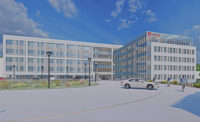New Pharmacy Building at University of Utah Goes for LEED Gold








Numerous efficiency features are being incorporated into the University of Utah's L.S. Skaggs Pharmacy Building, which will open next summer in Salt Lake City. For example, automated sashes and proximity sensors will reduce air-flow rates when laboratory hoods are not in use. Reclaimed laboratory wastewater will be used to flush toilets and urinals, and radiant-heated slabs will melt snow at the building's entrance.
The entire 150,000-sq-ft complex, including the current building, will be named the L.S. Skaggs Pharmacy Institute after Leonard S. Skaggs Jr., the retail force behind such well-known grocery and drugstore chains as Acme, Safeway, Albertsons, Longs and others.
The $69-million construction was fully funded by private donations, mainly from the Skaggs family and related entities—the ALSAM Foundation and the Skaggs Institute for Research.
L.S. Skaggs Jr. had funded the original building, built in 1965 and named after his father, L.S. Skaggs Sr.
A glass atrium will connect the new 30,000-sq-ft facility with the university's existing pharmacy building. In addition to functioning as a four-story bridge between the new and old structures, the atrium provides study areas and seminar and event space for the university's College of Pharmacy.
"The process started in 2006 with a vision for a pharmacy-research building that would bring our faculty and students back together again as they were in 1965," says John W. Mauger, a former dean of the college who helped spearhead the project until stepping down in 2009. "The idea for an atrium was to join the legacies of Mr. Skaggs and his father."
Upon completion, the institute will house the College of Pharmacy, which is currently dispersed across eight buildings throughout the campus.
In addition to four floors of teaching, office and laboratory space, the new building will have a basement-level vivarium for pharmacological studies with rodents. Part of the fourth floor will provide a home for the Utah Poison Control Center, which answers an average of 150 calls a day.
Jacobsen Construction of Salt Lake City is overseeing the building's construction, which broke ground in May 2010 and topped out in August.
The new building aims to earn LEED Gold. Energy models estimate that it will use 23% less energy than a typical laboratory project, exceeding the state's LEED-Silver requirements.
The building also will meet the university's goal for water reduction, using about 37% less domestic water than a comparable building.





